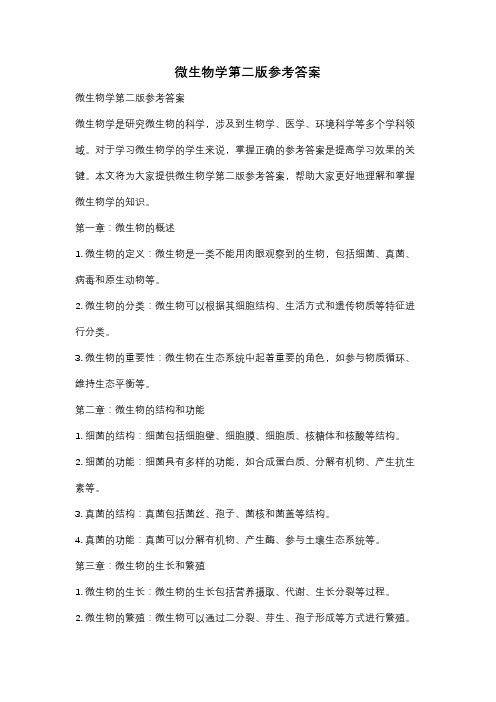第二章微生物的命名分类
微生物学第二章真核微生物

细胞膜
酵母菌的细胞膜与原核生 物的基本相同。但有的 酵母菌如酿酒酵母中含 有固醇类(甾醇)、麦 角固醇,这在原核生物 是罕见的。
微生物学第二章真核微生物
细胞质
细胞质主要是溶胶状物质, 在细胞质中含有各种功能 不同的结构——细胞器: 核糖体、线粒体、内质网、 微体等。
核糖体
酵母菌的核糖体为80S, 由60S和40S大小亚基构 成。它游离在细胞质中或 附着在内质网上。如图
微生物学第二章真核微生物
一.概述
酵母菌是一类单细胞真菌的俗 称,分类学上分属于 :
子囊菌亚门、担子菌亚门和半知菌 亚门。
特征: 1.个体一般以单细胞状态存在; 2.多数营出芽生殖,有的裂殖; 3.能发酵糖类产能; 4.细胞壁常含有甘露聚糖; 5.喜在含糖量较高、酸度较大的水生环境中生长。
微生物学第二章真核微生物
真核微生物特点:
凡是细胞核具有核膜、能进行有丝分裂、细胞质中 存在线粒体或同时存在叶绿体等细胞器的微小生物, 都称为真核微生物(Eucarvotic microbes)
微生物学第二章真核微生物
原核生物与真核生物的区别
( 1 )原核生物的遗传物质主要是以双螺旋 DNA 构成的一条染色体,仅形成一个核区, 没有核膜包围,无核仁,称为原核 (nucleoid) 或拟核,无组蛋白与之相结合。真核生物的遗 传物质以双螺旋 DNA 构成一条或一条以上的 多条染色体群,形成一个真核 (nucleolus) , 有一核膜包围,膜上有孔,有核仁,明显有别 于周围的细胞质,并有组蛋白与之相结合。而 且各种细胞器如线粒体、叶绿体携带有自己的 DNA ,可自主复制。
微生物学第二章真核微生物
二.酵母菌的形态和大小
细胞直径比细菌粗10倍左右,如啤酒酵母细胞的 宽度为2.5~10μm,长度为4.5~21μm。因此在光学显 微镜下可以模糊地看到它们细胞内的各种结构分化。 酵母菌细胞的形态通常有球状、卵圆状、椭圆状、柱 状或香肠状等多种。
第二章 微生物的形态、结构与功能

(一)细菌细胞的基本结构
(1)细胞壁的结构
1)革兰氏阳性菌的细胞壁 G+菌细胞壁是一层,厚约 20~80nm ,由肽聚糖网架 结构填充磷壁质和少量脂类 组成。其中肽聚糖含量高, 约占细胞壁重的40%~90%, 且网状结构致密。 肽聚糖(peptidoglycan): 由N-乙酰葡萄糖胺(NAG)、 N-乙酰胞壁酸(NAM)和短肽 聚合而成的多层网状结构的 大分子化合物。
真正的核,有核膜、核仁 1至数条,与RNA、组蛋白合 80S(细胞质中),70S(细胞器中) 有丝分裂,减数分裂 有 线粒体、高基体、内质网等 线粒体上 多聚糖,几丁质 10~100μ m
第二章 微生物的形态、结构和功能
原核微生物 “三菌”、“三体”和古生菌 真核微生物 真菌、原生动物和单细胞藻类 非细胞生物 病毒、类病毒、朊病毒等
原核微生物与真核微生物 在细胞结构上的区别
原核微生物与真核微生物 在细胞结构上的根本区别
Table2-1
原核微生物
拟核,无核膜、核仁 1条 70S 二分裂 无 无 细胞膜上 肽聚糖、磷壁质 1~10μ m
生物性状
核 DNA 核糖体 细胞分裂 有性生殖 细胞器 呼吸链 细胞壁成分 大小
真核微生物
三、细菌细胞结构及其功能
细菌的结构可分为一般 结构和特殊结构两部分 基本结构: 细胞壁 细胞膜 拟核 细胞质 内含物 特殊结构: 荚膜、芽孢、鞭毛和纤毛 等部分。
(一)细菌细胞的基本结构
1.细胞壁(cell wall) 细胞壁是位于细胞最外层的一层坚韧而略具弹性 的结构。约占细胞干重的10%~25%;在一般光学显微 镜下不易观察到。
(二)杆菌(Bacillus)
第二章 微生物的分类鉴定

细菌常用固相杂交法:
(参照菌株)A菌 B菌(待测) ↓ ↓ DNA DNA ↓ ↓ ( 同位素标记、酶切并解链)单链 单链(固定于滤膜上,未标记) ↓ 最适温度复性杂交 ↓ 洗涤 ↓ 测定放射强度 ↓ 杂交率(以参照菌株自身复性的放射性值为百分之百 ) ﹥60%同一个种;﹥70%同一亚种;20~60%同属不同种
对于许多有争议的种的界定和建立新种起了重要作用
② DNA-rRNA杂交 rRNA是DNA转录的产物,在生物进化过程中, 其碱基序列的变化比基因组要慢得多,保守得多, 它甚至保留了古老祖先的一些碱基序列。因此, 当两个菌株的DNA-DNA杂交率很低或不能杂交 时,用DNA-rRNA杂交仍可能出现较高的杂交 率,因而可以用来进一步比较关系更远的菌株之 间的关系,进行属和属以上等级分类单元的分类。 DNA-DNA杂交和DNA-rRNA杂交的原理和方法 基本相同,只是在技术细节上有些差异,如 DNA-rRNA杂交中,用同位素标记的是rRNA而 不是DNA等等。
(5)对氧的要求 好氧、微好氧、厌氧及兼性厌氧 (6)对温度的适应性 最低温、最适温、最高温、产物积累温度、 致死温度 (7)对PH的适应性 在一定PH条件下的生长能力及生长的PH范围 生长的PH范围:肠道细菌较宽;血液寄生微生 物较窄,因循环系统PH一般稳定在7.3
微生物学各章知识点总结

微生物学各章知识点总结第一章:微生物的概念和分类体系1. 微生物的概念微生物是指肉眼不可见的微小生物体,包括细菌、真菌、病毒和原生动物等。
它们在自然界中广泛分布,对生态系统的循环和平衡起着重要作用。
2. 微生物的分类体系微生物按照生物学特征可以分为原核生物和真核生物两大类,其中原核生物包括细菌和蓝藻,真核生物包括真菌和原生动物。
此外,病毒是一种非细胞生物,通常被单独归类。
第二章:微生物的结构和形态1. 细菌的结构和形态细菌是单细胞微生物,其主要结构包括细胞壁、细胞膜、胞质和遗传物质。
细菌的形态多样,包括球菌、杆菌和螺旋菌等。
2. 真菌的结构和形态真菌是多细胞或单细胞微生物,其主要结构包括菌丝、分生子、孢子和细胞壁等。
真菌的形态多样,包括酵母菌、霉菌和子囊菌等。
3. 病毒的结构和形态病毒是非细胞微生物,其主要结构包括蛋白质外壳、遗传物质和蛋白质套等。
病毒的形态多样,包括线状、球状和多棱体等。
第三章:微生物的生长和繁殖1. 细菌的生长和繁殖细菌的生长是指细胞的增加和分裂过程,主要包括营养摄取、分裂和排泄等。
细菌的繁殖有二分裂、分裂和梭孢子等方式。
2. 真菌的生长和繁殖真菌的生长是指菌丝的延伸和分支过程,主要包括分生子的产生和分裂等。
真菌的繁殖有无性生殖和有性生殖两种方式。
3. 病毒的生长和繁殖病毒的生长是指在寄主细胞内复制遗传物质和合成蛋白质,主要包括吸附、穿透和复制等。
病毒的繁殖有裸核和包膜两种方式。
第四章:微生物的代谢和营养1. 细菌的代谢和营养细菌的代谢包括异养和自养两种方式,同时也可根据在氧气的存在下进行厌氧和需氧代谢。
细菌的营养包括糖类、氨基酸和脂肪等多种。
2. 真菌的代谢和营养真菌的代谢包括异养和自养两种方式,同时也可根据生长温度进行低温菌和高温菌。
真菌的营养包括糖类、氨基酸和无机盐等多种。
3. 病毒的代谢和营养病毒是非细胞生物,因此没有自身代谢和营养循环,其复制和生长需要依赖寄主细胞的物质和能量。
微生物的形态与结构(共184张PPT)

质粒的起源
质粒的起源,人们认为质粒可能是来源于某种感染细菌的病毒粒子,
进入细胞后与细胞形成共生关系(与线粒体相似)
细菌细胞的特殊结构 P23
所谓特殊结构,指一部分 细菌才具有的结构。
• 鞭毛和菌毛 • 荚膜 • 芽孢 • ·········
细菌细胞的特殊结构 ——鞭毛
• 定义
革兰氏阳性细菌的细胞壁
革兰氏阴性细菌的细胞壁
革兰氏阳性菌和阴性菌的染色原理
——二者细胞壁结构的差异
细胞壁结构与革兰氏染色的关系
• 现在大多认为,在染色过程中,细胞内形成了一种不溶性的结晶紫 - 碘的 复合物,这种复合物可被乙醇 ( 或丙酮 ) 从 G - 细菌细胞内抽提出来,但 不能从 G + 菌中抽提出来。这是由于
• 霍乱弧菌 ( Vibrio cholerae ~0.6 × 1~3
• 迂回螺菌 ( Spirillum volutans ~2 × 10~20
2.2.2 细菌细胞的结构与功能
2.2.2.1 细菌细胞的基本结构 • 细胞壁 • 细胞膜 • 细胞质 • 细胞核
细菌细胞的结构
• 定义
细菌细胞的基本结构
第二章 微生物的形态与结构
2.1 微生物的基本类型
传统的生物界分为:
• 动物 • 植物 • 微生物
以细胞结构对微生物分类
根据显微镜或电镜观察到的结构进行分类
• 无细胞结构
病毒 及亚病毒 拟病毒 类病毒 朊病毒
• 有细胞结构
原核 细菌 放线菌 蓝细菌
真核
酵母菌 霉菌 藻类 原生动物
动物 植物
原核细胞和真核细胞的电镜图
其中PHB可以用来制作可降解塑料。
微生物学第二版参考答案

微生物学第二版参考答案微生物学第二版参考答案微生物学是研究微生物的科学,涉及到生物学、医学、环境科学等多个学科领域。
对于学习微生物学的学生来说,掌握正确的参考答案是提高学习效果的关键。
本文将为大家提供微生物学第二版参考答案,帮助大家更好地理解和掌握微生物学的知识。
第一章:微生物的概述1. 微生物的定义:微生物是一类不能用肉眼观察到的生物,包括细菌、真菌、病毒和原生动物等。
2. 微生物的分类:微生物可以根据其细胞结构、生活方式和遗传物质等特征进行分类。
3. 微生物的重要性:微生物在生态系统中起着重要的角色,如参与物质循环、维持生态平衡等。
第二章:微生物的结构和功能1. 细菌的结构:细菌包括细胞壁、细胞膜、细胞质、核糖体和核酸等结构。
2. 细菌的功能:细菌具有多样的功能,如合成蛋白质、分解有机物、产生抗生素等。
3. 真菌的结构:真菌包括菌丝、孢子、菌核和菌盖等结构。
4. 真菌的功能:真菌可以分解有机物、产生酶、参与土壤生态系统等。
第三章:微生物的生长和繁殖1. 微生物的生长:微生物的生长包括营养摄取、代谢、生长分裂等过程。
2. 微生物的繁殖:微生物可以通过二分裂、芽生、孢子形成等方式进行繁殖。
3. 微生物的生长曲线:微生物的生长曲线包括潜伏期、指数期、平台期和死亡期等阶段。
第四章:微生物的遗传与变异1. 微生物的遗传物质:微生物的遗传物质包括DNA和RNA,其中DNA是主要的遗传物质。
2. 微生物的遗传变异:微生物可以通过基因突变、基因重组等方式发生遗传变异。
3. 微生物的遗传传递:微生物的遗传信息可以通过垂直传递和水平传递进行传递。
第五章:微生物的代谢与生态1. 微生物的代谢类型:微生物的代谢包括光合作用、呼吸作用、发酵作用等多种类型。
2. 微生物的生态功能:微生物在生态系统中参与物质循环、能量转化等功能。
3. 微生物的微生态系统:微生物可以形成微生态系统,如肠道微生态系统、土壤微生态系统等。
第六章:微生物与人类1. 微生物与人类的关系:微生物与人类有着密切的关系,如参与人体免疫、引起疾病等。
第二章 原核微生物

细菌的大小 细菌的大小测量单位是μm
12
大小的测量方法
显微镜测微尺
显微照相后根据放大倍数进行测算
13
细菌的大小以微米(µm)计。 多数球菌的大小(直径)为0.5~2.0 µm; 杆菌(长×宽)为(1~5)×(0.5~1.0)µm; 螺旋菌(宽度×弯曲长度)为(0.25~1.7)×(2~ 60)µm;
49
由于芽孢具有上述本领,可以对不良环境:高温、干 燥、光线、化学药物有很强的抵抗力。例如: 细菌的营养细胞在70~80℃时10min就会死亡,可芽孢 在120~140℃时可生存几个小时。
特殊结构
鞭毛
螺旋丝
细胞壁结构 细胞膜功能 细胞壁功能
一般构造: 钩型鞘
基体
G﹣细菌鞭毛
螺旋丝
钩型鞘 L-环 外膜 外膜 P-环 肽聚糖 S-环
80%。
细胞质的主要成分为核糖体、内含颗粒、拟核、多 种酶类和中间代谢物、各种营养物等。
31
细胞质内含物 核糖体
核糖体是细胞质中的一种核糖、核蛋白的颗粒状物质 由核糖核酸RNA(60%)和蛋白质(40%)组成,常以游离 状态或多聚核糖状态分布于细胞质中。它是蛋白质的 合成场所。
32
细胞质内含物 内含颗粒
④膜上含有进行能量代谢的酶系,在细胞质膜上进行物 质代谢和能量代谢,是细胞的产能场所;
⑤细胞质膜上有鞭毛基粒,是鞭毛基体的着生部位和鞭 毛旋转的供能部位 ⑥ 维持细胞内正常渗透压。
30
细胞质和内含物
细胞质
细胞质(cytoplasm)是细胞质膜包围的除核区外 的一切半透明、胶状、颗粒状物质的总称。含水量约
A
(3)脱色(95%乙醇10-20S)
A
微生物分类

亚种(subspecies)或变种 ② 亚种 )或变种(variety): :
为种内的再分类。 为种内的再分类。 当某一个种内的不同菌株存在少数明显而稳定的变异特征或遗传形 当某一个种内的不同菌株存在少数明显而稳定的变异特征或遗传形 特征 状,而又不足以区分成新种时,可以将这些菌株细分成两个或更多 而又不足以区分成新种时, 的小的分类单元——亚种。 亚种。 的小的分类单元 亚种 变种是亚种的同义词,因“变种”一词易引起词义上的混淆,从 变种是亚种的同义词, 变种”一词易引起词义上的混淆, 1976年后,不在使用变种一词。通常把实验室中所获得的变异型菌 年后, 年后 不在使用变种一词。 称之为亚种。 株,称之为亚种。 如:E.coli k12(野生型)是不需要特殊 的,而实验室变异后,可 (野生型)是不需要特殊aa的 而实验室变异后, 获得某aa的缺陷型 的亚种。 从k12获得某 的缺陷型,此即称为 获得某 的缺陷型,此即称为E.coli k12的亚种。 的亚种
例:大肠埃希氏杆菌 Escherichia coli (Migula)Castellani et Chalmers 1919 金黄色葡萄球菌 Staphylococcus aureus Rosenbach 1884
◆当泛指某一属微生物,而不特指该属中某一种(或未
定种名)时,可在属名后加sp.或ssp.(分别代表species 缩写的单数和复数形式) 例如:Saccha:大肠埃希氏杆菌的两个菌株: 例如:大肠埃希氏杆菌的两个菌株: Escherichia coli B 和Escherichia coli K12 ★菌株的表示法: 菌株的表示法:
如果说种是分类学上的基本单位,那末菌株实际上是应用的基本单位, ★如果说种是分类学上的基本单位,那末菌株实际上是应用的基本单位, 因为同一菌种的不同菌株在产酶上种类或代谢物产量上会有很大的不同和 差别! 差别!
- 1、下载文档前请自行甄别文档内容的完整性,平台不提供额外的编辑、内容补充、找答案等附加服务。
- 2、"仅部分预览"的文档,不可在线预览部分如存在完整性等问题,可反馈申请退款(可完整预览的文档不适用该条件!)。
- 3、如文档侵犯您的权益,请联系客服反馈,我们会尽快为您处理(人工客服工作时间:9:00-18:30)。
Three-domain system (三域系统)
Woese system
• 根据: 16S rRNA 序列分析结果 • 16S rRNA: 分子化石,核糖体组成部分
Woese system (Three domains)
• Domain (域): 最初叫 superkingdom (超级界) • 3 domains: 原核细胞型分为2域 ⑴ Bacteria (细菌域): including: eubacteria, cyanobacteria. 注意古细菌的叫法: ⑵ Archaea (古生菌域): Archaebacteria (古细菌), including: archaebacteria. Archaea (古生菌√) ⑶ Eukarya (真核生物域): 真核细胞型合为1域 including: protista, fungi, plants, animals.
补充:2 种细胞型的概念 • 原核细胞型:原核生物界(真细菌,蓝 细菌,古细菌) • 真核细胞型:原生生物界(微藻,原生 动物),真菌界(酵母菌,霉菌,蕈 菌),植物界,动物界
五界系统中, 微生物占三界
Question: • Cyanobacteria were also called bluegreen algae before, so what’s the difference between cyanobacteria and algae ?
1 The levels of classification 第一节 分类的级别
Domain:域 Most geClass:纲
Order:目
Most specific (in descending order) Family:科 Genus (genera):属 Species:种
8 levels
2 Binomial system of nomenclature 第二节 微生物的命名 (双名法)
• Binomial system: two-name system (双名法). Swedish botanist, Linnaeus (1701-1778). 学名, 拉丁名 • Latin: Genus name + species name (属名+种名). 属名: 名词; 种名: 形容词 • 中文: 种名+属名; 种名在前, 属名在后 • Staphylococcus aureus (金黄色葡萄球菌) • Escherichia coli (大肠埃希氏菌, 大肠杆菌) • 缩写: S. aureus; E. coli
*: qqchen36@
• Taxonomy (分类学) — Organizing, classifying, and naming microorganisms
• Microorganism is a collective name, not a classifying name, because these subgroups are not closely related. • Such unrelated organisms are grouped as a common study subject called microbiology because they have two properties linking them: a. their small size; b. the common techniques for cultivating, identifying, studying and applying them.
Informal name (俗称): Staphylococcus aureus, Staphy (金黄色葡萄球 菌,金葡)
3 Classification systems 第三节 分类系统
• Five-kingdom system (五界系统): Whittaker system, traditional system • Three-domain system (三域系统): Woese system
第2章 微生物的命名与分类 Taxonomy of Microorganisms
A Microbiology Course by Bo CHEN (e-mail: qqchen36@)
CONTENTS (内容)
第一节 分类的级别 第二节 微生物的命名(双名法) 第三节 分类系统(五界系统、三域系统) 1. The levels of classification 2. Binomial system of nomenclature 3. Classification systems
Eubacteria
Cyanobacteria-bacteria with photosynthesis
Rabbit Creek, Yellowstone National Park
Archaebacteria
The Kingdom Protista (Protists) ⑵ 原生生物界
• Microscopic algae (微藻) photosynthetic cells with rigid walls, unicellular. • Protozoa (原生动物 protozoans) animal-like creatures that feed on other live or dead organisms and lack cell walls. • 都是真核细胞;与植物、动物的区别
Moulds-Filamentous fungi
Penicillium (青霉 )
Rhizopus (根霉
Mushrooms (大型真菌, 蕈菌, 菌物)
The Kingdom Plantae (Plants) ⑷ 植物界
The Kingdom Animalia (Animals) ⑸ 动物界
What about viruses ?
• What’s the position of viruses in classification systems?
What about viruses ?
• Note: Viruses are not included in any of the classification systems, because they are not cells! They are noncellular microbes!
The Kingdom Fungi (Myceteae) ⑶ 真菌界
• Yeasts (酵母菌, unicellular fungi) • Moulds (霉菌, molds, filamentous fungi 丝状 真菌) • Mushrooms (大型真菌)
Yeasts-unicellular fungi
Five-kingdom system
( 五 界 系 统 )
Traditional Whittaker classification system
The Kingdom Procaryotae (Monera) ⑴ 原核生物界
• • • • • • • • Eubacteria (真细菌) Cyanobacteria (蓝细菌) Archaebacteria (古细菌 archaeobacteria) 都是原核细胞 所有原核生物都是微生物 (原核微生物) 真细菌:无光合作用 蓝细菌:有光合作用 古细菌:生理、遗传与真细菌存在很大差异
